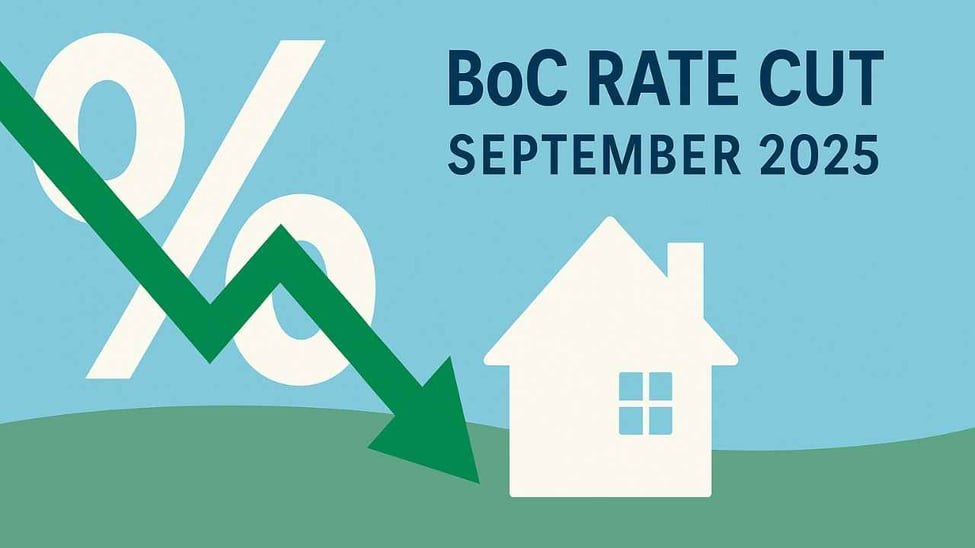It is Forecasted that a 25 bps Bank of Canada cut on September 17 will occur after a larger-than-expected Q2 GDP contraction. Here’s how that pivot could ripple through mortgages and the GTA housing market.
By Sisters Ragona • Updated
Key Takeaways
- Markets shifted from “on hold” to a probable 25 bps cut on Sept 17.
- The pivot follows a weaker Q2 GDP print and easing inflation pressures.
- Variable mortgages feel cuts fastest via prime.what is
- GTA buyers get a short-term leverage window before sentiment turns.
- Sellers win with sharp pricing, staging, and flexible terms.
Why Markets Pivoted Toward a September Cut
- Q2 GDP miss: Output contracted more than forecast, signaling slower demand into fall.
- Disinflation progress: With price pressures easing, growth risks get more weight.
- Tighter financial conditions: Elevated rates have crimped household spending and business investment.
Together, these factors raised concerns that holding too tight for too long could overtighten the economy. Futures now reflect a high probability of a 25 bps reduction on September 17, with the BoC staying data-dependent thereafter.
What a 25 bps Cut Actually Does
One cut won’t reset affordability—but it changes the trajectory.
- Variable-rate mortgages: Prime rate usually drops shortly after a BoC cut, lowering payments within weeks.
- Fixed-rate mortgages: Often drift down as Government of Canada bond yields price a looser policy path.
- Other credit: HELOCs and business lines see modest relief, supporting turnover and renovations.
GTA Housing: A Window Before the Crowd Returns
The Greater Toronto Area has been in a “more listings, softer prices” phase, giving buyers leverage. If the BoC signals the start of an easing cycle, sentiment can improve faster than prices. The next 30–90 days could be a pocket where you negotiate strongly before multiple offers "could" return selectively.
Affordability Reality Check
- Stress-test at +200 bps over your quoted rate.
- Keep a 3–6 month cash buffer for taxes, utilities, and maintenance.
- Pick a term strategy that fits your risk: shorter fixed if you expect a cutting cycle; variable if you want immediate participation and can tolerate bumps.
Action Plan for Buyers
- Lock a pre-approval now: Rate holds protect you if yields pop; you win if they fall.
- Shop widely: Use inventory breadth—expand area and property type filters.
- Bid with comps, not vibes: Use days-on-market and condition issues to justify adjustments.
Action Plan for Sellers
- Price to today: Data-driven buyers punish aspirational pricing.
- Win the click: Staging, pro photos, floor plans, and accurate copy drive traffic.
- Be flexible: Clean conditions and adaptable closings capture early momentum if demand lifts post-decision.
Action Plan for Investors
- Target value-add freeholds (suite potential) and turnkey homes.
- Underwrite for cap-rate durability—assume financing costs don’t fall in a straight line.
- Prioritize fundamentals: transit, schools, walkability, and future supply pipelines.
Three Post-Meeting Scenarios
- Base case: 25 bps cut + “data-dependent” tone → modest lift in activity into fall.
- Dovish surprise: 25 bps cut + guidance for more easing → faster sentiment rebound; selective multiple offers especially in the city core.
- Hold, dovish tone: Cut deferred to October; buyers keep negotiating with conditions.
The Takeaway
Markets now expect a September 17 cut—a clear shift from summer’s complacency. One move won’t solve affordability, but it does change psychology and direction. For GTA buyers, this fall could offer more choice, better leverage, and the first hint of cheaper money. For sellers, precision and presentation are non-negotiable as confidence rebuilds.

